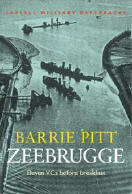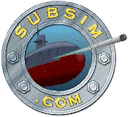Authors: Barrie Pitt
Publisher: Cassell Military Paperbacks
Year: 1958
Reviewer: TarJak
Zeebrugge: Eleven VCís Before
Breakfast tells a quite slanted view of what was actually a daring
series of raids attempting to block the Belgian harbour entrance in
1918. The story itself is fascinating with many characters and heroes
with the subtitle of the book proclaiming the amazing statistic of
eleven VCís being won before breakfast, not to mention the 21 DSOís and
29 DSCís awarded for the action.
What I found it lacked was some balance and more detailed examination of
the German side of the raids. Whilst there is some mention of cursory
research by the author, this lack means the story is really only half
told.
The half that is told though is riveting. How the initial raid was
conceived, attempted and aborted and finally carried out and the
subsequent follow up, that was found necessary is an amazing story of
human endurance, bravery and support of the participants for their
comrades in arms.
In 1917, the U-Boat menace was beginning to take its toll on the Allied
war effort. Operating out of occupied ports in Holland and Belgium, the
U-boats rising tally of sinkings was forcing Allied commanders to
consider drastic action to destroy or otherwise hamper their efforts.
Adm. Sir John Jellicoe was looking for an answer and conceived of some
form of raid as a way of doing just that. After little in the way of
positive action over the following 8 months, Vice Admiral Sir Roger
Keyes struck upon the idea of taking a flotilla of obsolete cruisers
into the mouth of the main channel into the harbour and sinking them
thereby blocking the mouth and rendering the harbour ineffective.
The bulk of the first 3/5 of the book is taken up with descriptions of
the conception planning and preparations for the raid and the remainder
is almost all action with a brief summing up of the results and a great
set of tables outlining the decorations handed out after this amazing
action.
The initiation of the plan is covered in good depth, outlining most of
the key players in making the decisions and also in their political or
other motivations for support or otherwise of the plan. there are some
period photos and diagrams of the harbour and the plan of the raid which
give a pretty clear indication of area in which the battle was engaged.
The narrative takes the reader through the key decisions and decision
makers in some detail, making some comment on their failings or foibles,
with the exception of Keyes and Capt. Alfred Carpenter VC, whose
reputations were unsullied in Pittís analysis.
The extraordinary preparations for the raid and some amazing stories of
the fervour displayed by the all volunteer crews and Royal Marine
detachment in their recruitment for the venture is laid out in chapters
dealing with the lead up to the raid.
As the story unfolds and the preparations reach fever pitch, there is
the predictable set back as it is realised that the success of the raid
is wholly dependant on the weather. The ingenious smoke screening
technology, developed by Wing Commander Frank Arthur Brock, whose
invention of the incendiary bullet spelled the end of the Zeppelin
menace, was fitted on a number of the small fast boats that accompanied
the raiders across the channel. These smoke generators were crucial in
creating an artificial fog which was to shroud the raiding ships as they
approached the mile long mole which extended out from the harbour
entrance.
An attempt to launch the raid on 2 April 1918 failed because the weather
conditions changed during the Channel crossing, meaning the ships would
have been exposed to German guns long before they would have the
opportunity to get close to effect the raid.
This set back in timing whilst frustrating enabled more time to train
and complete preparations. There where however some minor hiccups as
training injuries and even a death or two required reshuffling and
reorganisation around the fringes of the raid.
The plan itself remained unchanged and eventually the raid went ahead 21
days later. Pitts depiction of the events and tension in the approach of
the 77 ships is well written and gives a real sense of the strain that
the crews must have been under. As the raid proper got underway the
description of the various parts of the action are like a well scripted
movie shifting from HMS Vindictiveís hellish approach to the furious
fighting on the mole, to the heroic actions of the small fast boats and
submarines sacrificed to blow up the bridge between the mole and the
mainland and finally to the block ships themselves.
In my opinion, it is here that Pittís story is let down a little by the
lack of exploration of the German side of the battle. Some cursory
mention is made of the reports that were sent during and after the
action, which according to whether this was due to a lack of records or
Pitts ability to find German survivors of the raid in the mid 1950ís
when most of his research must have been done is not explained. As a
narrative of the British side of the engagement however, the book stands
up and will certainly be for me, the benchmark work on the action.
Pitt then recounts of the raid to block Ostend harbour in May of the
same year where HMS Vindictive, scarred and damaged from the Zeebrugge
raid, was finally sunk as a block ship herself. This action is only
summarily accounted for but again Pittís description is detailed enough
to give a sense of the bravery and courage the again all volunteer crews
possessed.
Overall the military effectiveness of both raids in the scheme of things
was not what the Admiralty could have wished. Channels around the sunken
block ships were dredged meaning that smaller patrol boats and U-boats
would use the harbour egress within weeks of the raids.
Interestingly, Pitts recount fails to mention that whilst the raids
failed in their aim of stopping or slowing the u-boats from operating
out of Brugges, larger warships were certainly trapped there until that
port was captured in October 1918. He also doesnít mention that the
blockages were not completely cleared until 1921!
The propaganda effect on the other hand was actually quite great. The
huge publicity in England proclaiming the success of the raids, largely
driven by the fact that so many decorations were handed out after the
raids, meant many of the senior crew members minor celebrities prior to
the Wars end. The book covers this in a bit of detail, but probably
stretches the morale effect a little more than it may have actually
been.
Pittís book stands as a solid monument to the valour of the men involved
in the planning and execution of the raids. It gives the reader a sense
of the political and military situation of the time and provides, at
least from the British side, a strong historical record of the action.
If you have an interest in military history and in particular less well
know naval actions of WWI, then Iíd recommend this as a good starting
point.
There are other books on the subject, some of which touch more on the
German side of the story than this does but overall this is a great
resource for research and provides a rivetting if a little skewed
depiction of the action. Zeebrugge: Eleven VCís Before Breakfast has
certainly given me a desire to investigate some of the others in search
of more information on the amazing events of April 1918.
 Zeebrugge:
Eleven VCís Before Breakfast
Zeebrugge:
Eleven VCís Before Breakfast
